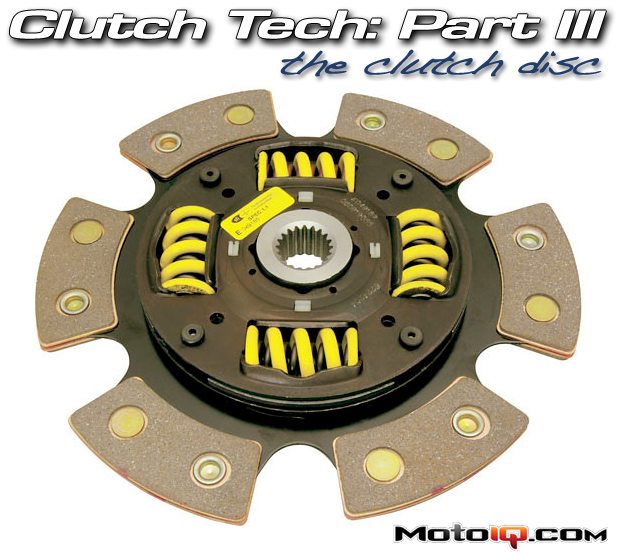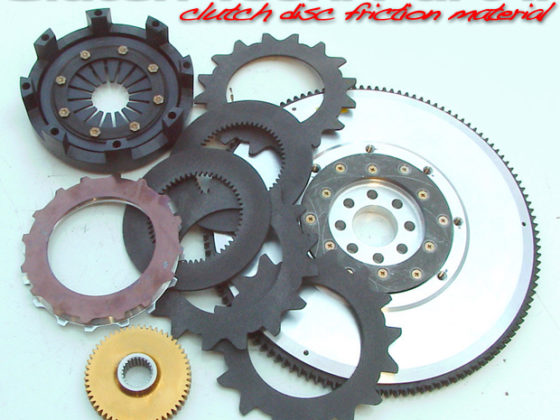Clutch Technology Part 3, Clutch Disc Construction
By Mike Kojima
Read Part 1 about how the clutch pressure plate works here!
Read Part 2 about clutch disc friction material here!
The clutch disc isn't just a simple round and flat disc that rubs against stuff to help transfer the engines torque to the wheels. It is actually a very sophisticated component that has many design features to help it do its job. The clutch disc has a very important set of functions. It must engage smoothly and predictably to help get a car underway, it should help cushion the drivetrain from excess shock and should have low inertial mass to speed shifting. Of course like all mechanical things there are many compromises that need to be considered with the design of clutch discs. To learn more, read on.
 |
| Jim Wolf Technology has put a Marcel spring in some of their full metal clutch discs to help make them relatively streetable. This is an unusual feature of JWT's engineering to make a race type clutch that can hold lots of power more streetable. |
Clutch discs have a few different features that control their operating properties. Most stock and HD clutches have what is called a Marcel spring. This is a wavy flat spring that is bonded to the friction material, and then riveted to the disc itself. You can see it when looking at a clutch disc on its edge. The marcel acts like a cushion, smoothing out the final engagement of the friction material by allowing the clamping forces to build up a little slower. When the clutch is fully engaged, the marcel smashes flat and has no effect.
 |
| The Marcel spring on this stock Nissan disc is this wavy piece of sheet metal. Its job is to make the clutch engagement more gradual and smooth. |
The marcel is removed from racing-type and metallic clutches for two reasons. The marcel prevents the friction material from being 100% bonded to the disc, reducing burst strength and it also increases engagement travel, possibly slowing shifts which is a little harder on the syncros. Some companies do innovative things to incorporate Marcel into semi-metallic and Kevlar metallic discs by bonding the friction material to a steel substrate first then riveting it to the marcel spring to increase burst strength.
The hub of the disc has some features that affect engagement characteristics also. Stock and HD clutches have sprung hubs. These are two floating hub pieces that have the disc with the friction material attached to one side and the transmission input shaft splines on the other. Captured coil springs or rubber bumpers are retained between the two hub sections to allow some rotational cushion when the clutch is let out. Sprung hubs really help make a clutch streetable to a large degree, meaning reducing chatter and jerk when letting the clutch out. Sprung hubs reduce the stress on the drivetrain that is caused by crank harmonic twisting.
 |
| Hub springs falling out of the hub is a major cause of clutch disc failure. This disc has a lot of coverage for the spring by the center retainer. The spring is not very likely to fall out of this disc. |
The sprung hub also helps reduce drivetrain noise. If you are into performance, however, then you should stay away from discs with rubber bumpers as they tend to get chewed up and fall out under hard use. Some discs also have weak spring retainers that crack and allow the coil springs to fall out, jamming up the clutch. The better discs have thicker stamping in this area and some nearly enclose the springs to prevent their falling out. They will also have strong stopper pegs to help take the stress of hard launches or shifts when the springs bottom out.
 |
| This stopper prevents the clutch disc from over-traveling and coil binding the hub springs. This helps prevent the hub springs from breaking. |
Extreme racing discs usually have no hub springs or Marcel. This is to get the crispest shifting action as the engagement and disengagement of the clutch is short, crisp and defined. This takes load off of the syncros by giving them more time to match revs and can make for very fast shifting. Without the complexities of the hub springing, the hub can be lighter and also stronger. Lightness is very important in a disc because it allows the input shaft of the transmission to spin down faster so the syncros work better. Solid hub discs, however, are very difficult to drive on the street and exhibit extreme on-off engagement characteristics making them hard to drive smoothly, and chattering upon engagement.
 |
| This Unorthodox racing clutch uses a solid hub and six pucks. It is a pretty extreme set up for a very high power car. |


